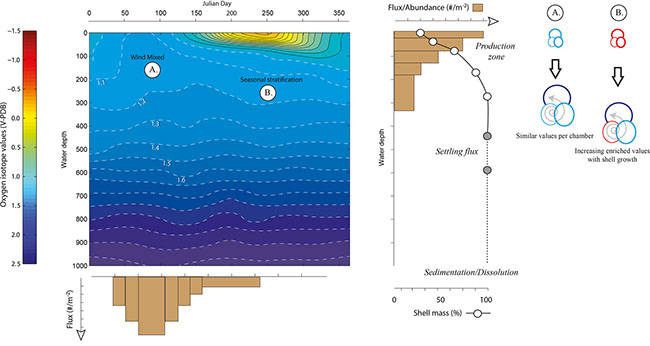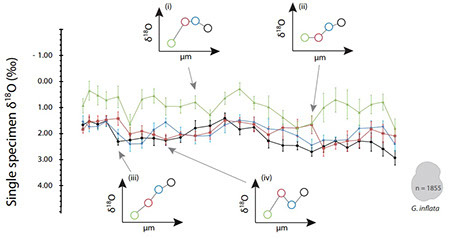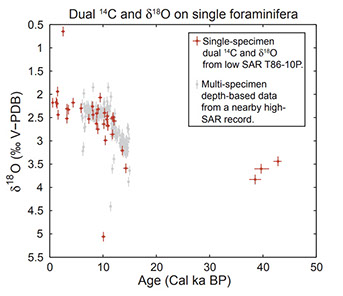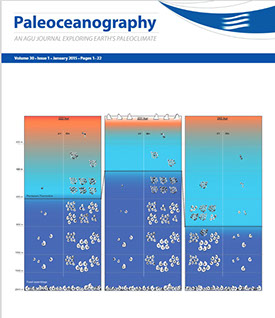research: Single specimen isotope analysis

Single shells of foraminifera can either reflect seasonality, depth habitat or a modifier (such as dissolution, bioturbation, etc).
Image from Pracht et al. (2018), modifed from Metcalfe et al. (2015).
The stable isotope composition of foraminifera is routinely measured using a pool of shells from a single species, this pooling has been referred to as conventional isotope analysis (CIA) by Ganssen et al. (2011). The results of monospecific pools of foraminifera are used by Palaeoclimatologists and Palaeoceanographers to infer the temperature of the past, global ice volume or as a stratigraphic tool for determining the age of ocean sediments. Pooling numerous shells gives an average value, although this may not reflect a climatological average (Mix et al., 1987; Roche et al., 2018; see Data-model comparison). Single specimen analysis also referred to as individual specimen analysis (ISA) or individual foraminiferal analysis (IFA) is oxygen or carbon isotope (δ18O; δ13C) analysis that enables a better understanding of the variability within the foraminiferal population. The variability identified within samples was shown by the pioneers almost 40 years ago (a quick 'recap' can be found in Ganssen et al.) in a paper entitled "Oxygen and carbon isotopes of individual shells of planktonic foraminifera from Ontong-Java plateau, equatorial pacific" (Killingley et al., 1981). In this paper Killingley et al. (1981) measured individuals of Orbulina universa with a size between 900 and 1100 μm to ensure that a mass of 100 μg was reached, this size range appears excessive, however it was a necessary requirement to gain sufficient sample gas in order to for the measured values to have a degree of precision. Early mass spectrometers used in palaeo-research required a large sample size (equivalent of 4.5 mg carbonate) that was slowly reduced (Shackleton et al. 1965) with modifications (Breitenbach et al., 2011; Fiebig et al., 2005; Ishimura et al., 2008) until most modern mass spectrometers (Ganssen et al., 2005; Ganssen et al., 2011; Koutavas et al., 2006a ; Niitsuma et al., 1991; Spero and Williams, 1990; Stott and Tang, 1996; Tang and Stott, 1993) have become capable of measuring single foraminifera of small mass or even individual chambers (Lougheed et al., 2018; Pracht et al., 2019; Takagi et al., 2015; Takagi et al., 2016).
Following on from this pioneering study(Killingley et al., 1981), numerous workers have used individual foraminiferal δ18O analysis of modern foraminifera to determine the depth habitat of species (Oba, 1990; 1991; Takagi et al., 2015; Takagi et al., 2016; Steinhardt et al., 2015); seasonality (Billups and Spero, 1996; Ganssen et al., 2011; Groenveld et al., 2019; Metcalfe et al., 2019; Naidu et al., 2019; Stott and Tang, 1996; Wit et al., 2010); ecology (Metcalfe et al., 2015; Mikis et al., 2019; Feldmeijer et al., 2015; Pracht et al., 2019; Sadekov et al., 2016); the occurrence of low salinity events (Spero and Williams, 1990; Tang and Stott, 1993; Vetter et al., 2017); ENSO dynamics (Koutavas et al., 2006a; 2006b; Koutavas and Joanides, 2012; Leduc et al., 2009; Rustic et al., 2015); expatriation (Scussolini et al., 2013; van Sebille et al., 2015); and bioturbation (Lougheed et al., 2018; Stott and Tang, 1996; Wit et al., 2013). Such data has also helped in modelling of samples or determining sample uncertainty (Schiffelbein and Hills, 1984; Schiffelbein 1985; 1986; Wit et al., 2013), with analytical tools including: the Individual Foraminiferal approach uncertainty analysis - INFAUNAL (Thirumalai et al., 2013); the Foraminiferal Isotope Reproducibility Model - FIRM (Fraass and Lowery, 2017); and Sedproxy (Dolman and Laepple, 2018). Therefore, through the use of individual foraminiferal analysis it is possible to not only better understand the climate system but to (critically) assess our proxy archives.

Single shell oxygen isotope data down core for different size fractions (Metcalfe et al., 2015).

Dual radiocarbon analysis allows us to plot individual isotope values against a calibrated age.
Modified from figure 5 of Lougheed et al., 2018.
Of course,individual foraminiferal analysis does not only refer to studies using δ18O, as referred to above, but can also refer to Laser Ablation (Eggins et al., 2003; Hathorne et al., 2003; Reichert et al., 2003) or a Flow-Through Automated Cleaning (Haarmann et al., 2011; Haley and Klinkhammer, 2002; Klinkhammer et al., 2004; Groenveld et al., 2019) trace metal geochemistry (Allen et al., 2016; Fehrenbacher et al., 2015; Ford et al., 2015; Ford and Ravelo, 2018; Mezger et al., 2016; Mezger et al., 2018; Sadekov et al., 2009; 2013; Steinhardt et al., 2015; Vetter et al., 2013; Vetter et al., 2017; Wit et al., 2010; White et al., 2018) as well as small sample radiocarbon analysis (Lougheed et al., 2012; Ruff et al., 2010; Synal et al., 2007; Wacker et al., 2013a; 2013b; 2013c). Several studies have also used either paired measurements, wherein the same shell is measured for two proxies (Wit et al., 2010; Vetter et al., 2017) or a second sample has either pooled or individual measurements performed (Ganssen et al., 2011; Sadekov et al., 2016; Steinhardt et al., 2015; Groenveld et al., 2019) to correct or further elucidate palaeoclimatological information from either proxy (Elderfield and Ganssen, 2000; Mashiotta et al., 1999; Mekik, 2018; Rosenthal et al., 2000).
Recently we coupled stable isotope analysis of benthic foraminifera with radiocarbon measurements from the same single shell (Lougheed et al., 2018) using the Mini Carbon Dating system (MICADAS) developed at ETH Zurich, the small sample radiocarbon approach (for various materials) has been outlined in a number of papers (Fagault et al., 2019; Fewlass et al., 2019; Gottschalk et al., 2018; Haghipour et al., 2019; Lougheed et al., 2012; Ruff et al., 2010; Synal et al., 2007; Szidat et al., 2014; Wacker et al., 2013a; 2013b; 2013c). Instead of inferring the age of the package of sediment through an age model, which we pick out individual specimens of foraminifera for analysis from, dual analysis can be used to give each measured isotope value an age. This approach may help us to better understand the past.

Cover of the AGU Journal Paleoceanography
(Feldmeijer et al., 2015).
In-preparation/Submitted
Peer-reviewed
Vonhof, H.B., de Graaf, S., Spero, H.J., Schiebel, R., Verdegaal, S.J.A., Metcalfe, B., and Haug, G.H. (2020). High-precision stable isotope analysis of < 5 µg CaCO3 samples by continuous-flow mass spectrometry. Rapid Communications in Mass Spectrometry, DOI: 10.102/rcm.8878
Brummer, G.-J.A.., Metcalfe, B., Feldmeijer, W., Prins, M.A., van 't Hoff, J., and Ganssen, G.M., (2020) Transient seasonality during the last deglaciation. Climate of the Past , DOI: 10.5194/cp-2018-144
Metcalfe, B., Feldmeijer, W., and Ganssen, G.M. (2019). Oxygen isotope variability of planktonic foraminifera provide clues to past upper ocean seasonal variability. Paleoceanography and Paleoclimatology
DOI: 10.1029/2018PA003475
Pracht, H., Metcalfe, B., and Peeters, F.J.C., (2019). Oxygen isotope composition of final chamber of planktic foraminifera provides evidence for vertical migration and depth integrated growth Biogeosciences, 16 (2), 643-661
DOI: 10.5194/bg-2018-146
Lougheed, B.C., Metcalfe, B., Ninnemann, U.S., and Wacker, L., (2018). Moving beyond the age–depth model paradigm in deep-sea palaeoclimate archives: dual radiocarbon and stable isotope analysis on single foraminifera. Climate of the Past 14, 515-526.
DOI: 10.5194/cp-2017-119
Metcalfe, B., Feldmeijer, W., de Vringer-Picon, M., Brummer, G.-J.A., Peeters, F.J.C. and Ganssen, G.M. (2015). Late Pleistocene Glacial–Interglacial related shell size isotope variability in planktonic foraminifera as a function of local hydrology. Biogeosciences 12 (15), 4781-4807. DOI: 10.5194/bg-12-4781-2015
Feldmeijer, W., Metcalfe, B., Brummer, G.-J.A. Ganssen, G.M. (2015). Reconstructing the depth of the permanent thermocline through the morphology and geochemistry of the deep dwelling planktonic foraminifer Globorotalia truncatulinoides. Paleoceanography 30 (1), 1-22. DOI:10.1002/2014PA002687
Ganssen, G.M., Peeters, F.J.C., Metcalfe, B., Anand, P., Jung, S., Kroon, D. and Brummer, G.-J.A. (2011). Quantifying sea surface temperature ranges of the Arabian Sea for the past 20 000 years. Climate of the Past 7 (4), 1337-1349. DOI: 10.5194/cp-7-1337-2011